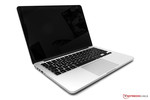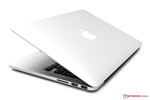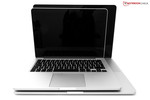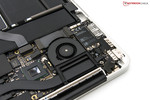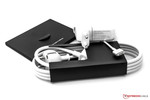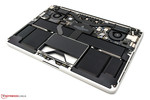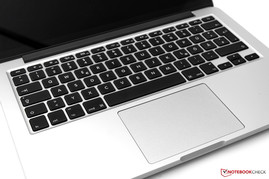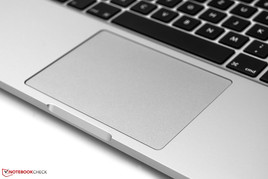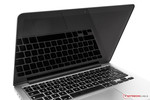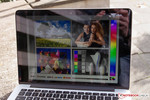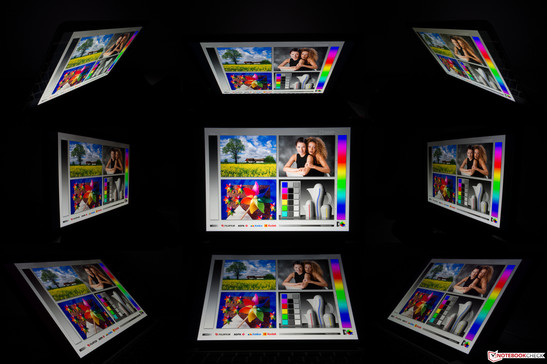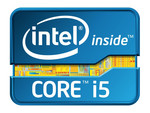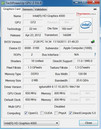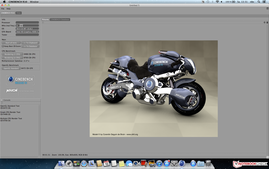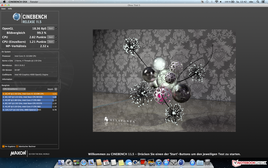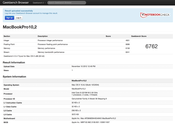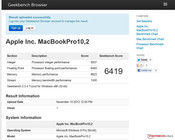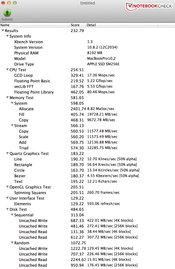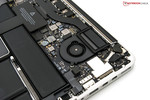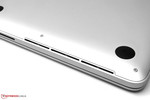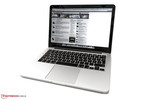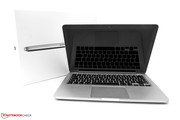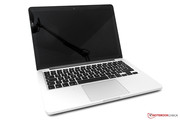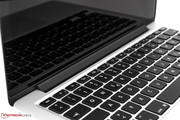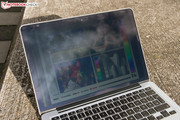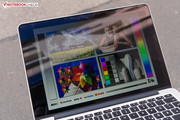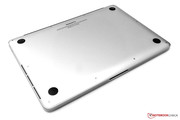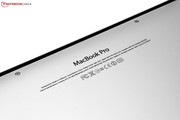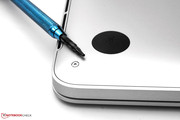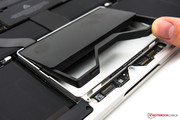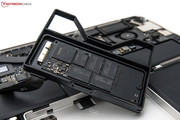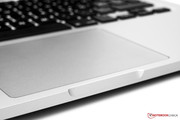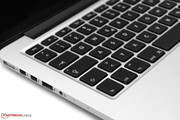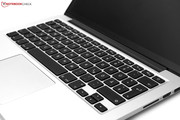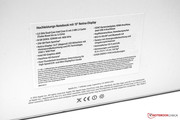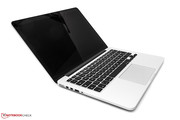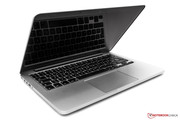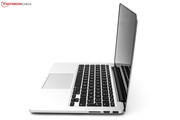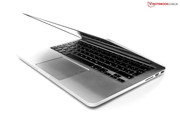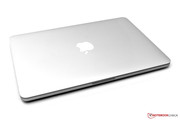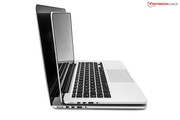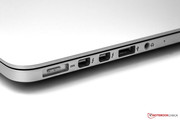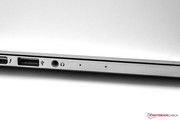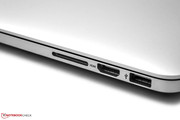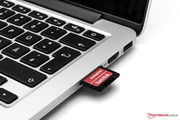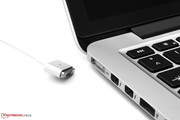Review Apple MacBook Pro 13 Retina 2.5 GHz Late 2012

On October 23rd, Apple not only released their new tablets (iPad 4 & iPad Mini) and a few additional updates across the product lines, but also introduced the MacBook Pro 13 with Retina. It was just a question of time: after the introduction of the Apple MacBook Pro 15 with Retina and subsequent releases from the competition, Apple probably reacted to the introduction of Ultrabooks like the Asus Zenbook Prime UX31A, which features a Full HD display. It might have been a business decision to not release the 13.3-inch model in parallel with the 15-inch Retina model - after all: the release of the bigger model certainly stirred up interest in a smaller model with a high resolution display.
The new model sets a new standard for 13.3-inch subnotebooks with a resolution of 2560x1600 pixels and 227 DPI. The Apple MacBook Pro 13 Mid 2012 only had 1280x800 pixels and was certainly behind the times. The MacBook Pro 15 Retina features an even higher resolution of 2800x1800 pixels and more powerful components to boot.
Speaking of components: our review model comes equipped with an Intel Core i5-3210M dual-core processor (2.5 GHz clock speed), integrated HD 4000 GPU, 8 GB RAM, and a 256 GB flash drive. For 200 Euros (~$260) more, the customer can opt for the more powerful Intel Core i7-3520M dual-core processor (2.9 GHz clock speed). Upgrades to 16 GB DDR3L RAM and a dedicated (Nvidia) GPU - both are options for the MacBook Pro 15 Retina - are not available.
Interested? The youngest member of the notebook series from Cupertino is certainly not for the frugal shopper: the price of admission starts at 1750 Euros (~$2275). Alternatively, Apple offers the 13.3-inch model without the high resolution display for 500 Euros (~$650) less. Let's see how well the new slim-line notebook performs in our series of tests and how it compares to its bigger brother.
Case
Slim notebooks are in - and there's no question that the new MacBook Pro 13 Retina fits the bill. The notebook with the high-resolution display features a brand new chassis, which is milled from a single solid piece of aluminum. Since the design also features an even thickness all around, it doesn't break tradition - the overall look of the Pro series hasn't been altered. As expected, there are no changes as far as the quality of the materials, rigidity of the unit, and fit and finish are concerned. Although the notebook is quite resilient and sturdy, we would still recommend a suitable carrying case for transport, as a sharp object could potentially mar the surface.
Compared to the MacBook Pro 13 Mid 2012, the overall thickness of the chassis has been reduced from 2.41 to 1.9 centimeters (0.95 to 0.75 inches). The difference of half a centimeter doesn't look like much on paper, but we noted an improvement in ergonomics: the palm of the hand doesn't get raised up quite as much - as a result, the sharp edge of the base unit is less noticeable. The predecessor's additional thickness sometimes caused issues right behind the wrists. Of course there's no free lunch: less volume also means less space for components. The Apple MacBook Pro 15 Retina is about one millimeter thinner than the little brother. On the other hand, the low weight is where the new 13-inch Pro shines: 1624 grams (3.58 pounds) is 440 grams lighter (0.97 pounds) than the MacBook Pro 13 Mid 2012 (old chassis style) and 400 grams (0.88 pounds) lighter than the 15-inch Retina model. The Asus Zenbook Prime UX31A weighs in at 1.41 kilograms (3.11 pounds).
One of the reasons for the reduction in weight (in addition to the thinner chassis and permanently integrated hardware) is the new display: the piece of glass that protected the panel has been omitted - Apple now uses a thinner dual-layer solution. One (unwanted) side effect: the display is significantly harder to clean. Glass cleaner is not suitable since it leaves streaks. A dry microfiber cloth is what works best - although it's still a constant battle to keep the display smudge-free without the use of any liquid. We do like the large display hinge, which is able to securely hold the display in any position with hardly any wobbles. Working with the notebook in a car, train, or airplane is possible without any restrictions.
Connectivity
The ports are located on the right and left side of the chassis. Despite the fact that the chassis is quite small, the selection doesn't differ from the larger MacBook Pro 15 Retina. In addition to two Thunderbolt connectors for external storage and monitors, the notebook also features two USB 3.0 ports and HDMI video out. Apple states that two external monitors can be used with the notebook display simultaneously. The notebook now sports all the ports a multimedia notebook would offer - although we would like to see a few more ports (a third USB port would be a good thing) and maybe a DVD optical drive. To date, Apple does not offer a Blu-Ray drive.
Communication
The subnotebook supports the current status quo as far as Internet connectivity is concerned: the integrated module from Broadcom offers both WLAN 802.11b/g/n and Bluetooth 4.0. Those familiar with the MacBook Pro 13 Mid 2012 will notice that the RJ-45 jack is absent. Should a cable-based connection be desired, the user needs to purchase a Gigabit Ethernet Adapter (available as an accessory), which is available for 30 Euros (~$39). UMTS or LTE modules are not offered - the only solution is to use an inexpensive USB dongle, which in turn uses up one of the two USB ports.
Accessories
Apple only supplies the most basic accessories. Aside from the notebook itself, the box includes the 65-Watt power adapter (with EU plug and cable), a cleaning cloth, various pamphlets, and the usual Apple stickers. Thunderbolt adapters or a sleeve for the notebook are optional; since there is a plethora of accessories available, it definitely pays to shop around.
Users of older Apple products need to be aware that the new power adapters feature the MagSafe 2 connector. The adapter costs 10 Euros(~$13) and is unfortunately not included (since the introduction of the MacBook Pro 15 Retina, Apple ships this adapter with the current crop of monitors).
Maintenance
The bottom plate of the MacBook Pro also functions as a large maintenance cover. Apple uses special pentalobe screws, thus making it difficult for the average user to open up the notebook. With a special screwdriver, removal of the screws is possible, although the heads are quite delicate and care must be taken.
Once the cover is removed, it becomes clear that expandability is very limited: the RAM is soldered onto the motherboard and the SSD is not a common 2.5-inch form factor. Some cells of the lithium-polymer battery are glued into the chassis, which caused Apple problems with the EPEAT certification not too long ago. The only reason to open the chassis might be to clean the system fan. Since Apple's Retail Partners offer cleanings for just a few Euros, it might be advisable to go that route. The Apple MacBook Pro 13 Retina only scores a 2 out of 10 points in iFixit's teardown .
Warranty
Apple covers their notebook for a period of 12 months and includes 90 days phone support. Not really a surprise - but the manufacturers of competing (often significantly cheaper) Windows systems offer longer periods without charging for it. A warranty extension to 36 months including phone support costs 250 Euros / ~$325 - or about 14 percent of the starting price of 1750 Euros (~$2275). The price for the additional warranty does not change even if the user chooses a more powerful (and more expensive) version of the notebook. Various Apple resellers offer less expensive options - but it has to be considered that the warranty is then tied to the place of purchase.
Input Devices
The input devices are a carry-over from the larger MacBook Pro 15 Retina. The keyboard features a comfortable layout, has good feedback and a backlight which is highly adjustable. The glass trackpad with integrated mouse buttons sets the standard for other manufactures: it's generously sized and responds extremely well to various multitouch gestures. For detailed information, please reference the link above.
Display
The most notable feature of the new Apple MacBook Pro 13 is without a doubt the high-resolution Retina display. Apple seems to gradually update the various screen sizes with the new technology - next year, we might see the MacBook Air 13, MacBook Air 11, as well as the iPad Mini with new displays. The 13.3-inch panel (type APPA014) has a native resolution of 2560x1600 pixels. 4 megapixels equals a pixel density of 227 DPI - even higher than the larger Apple MacBook Pro 15 Retina (15.4-inch display, 2880x1800 pixels, 5.2 megapixel - 220 DPI). Both screens are glossy -type - Apple does not offer a matte version of the Retina display.
Other manufacturers implement the Full HD standard of 1920x1080 pixels (1080p) - take the Asus Zenbook Prime UX31A for instance. For a 13.3-inch screen, Full HD screen works out to be 2.07 megapixels and 165 DPI. The difference in the pixel count is 48.8 percent. Even more glaring is the difference to the older MacBook Pro 13 Mid 2012: with its standard resolution of 1280x800 pixels, the numbers work out to be about one megapixel and 113 DPI (a difference of 75 percent).
In the last four months, many developers have been successfully optimized their applications for HiDPI displays. Well-know programs that haven't been updated yet are Microsoft's Office suite and various Adobe applications. Google Chrome and all Apple programs are able to support the higher resolution without any issues.
The resolution is adjusted via the system settings. The native resolution of 2560x1600 pixels can only be displayed with the help of an additional application, however. Not that this is really an issue - to work effectively with this kind of resolution, one would need a magnifying glass. The display supports scaling - the user can either choose 1024x640 pixels, 1280x800 pixels (MacBook Pro 13), 1440x900 pixels (MacBook Pro 15 Standard), or 1680x1050 pixels (MacBook Pro 15 Hi-Res). When the resolution is low, the pixel count goes up: "Optimal" (Retina) at 1280x800 has four times the number of pixels. If the application does not support the "pixel doubling", the advantage disappears, as four pixels are displayed in the same color.
We use the tool i1Pro 2 from X-Rite to evaluate display performance. We measured a maximum brightness of 351 cd/m² and a very good average brightness of 307.2 cd/m². The larger MacBook Pro 15 Retina doesn't do as well; the Asus Zenbook Prime UX31A and Samsung’s Series 9 900X3C-A04DE surpass the little MacBook. The duraluminum notebook from Samsung reaches a peak brightness of an astounding 420 cd/m². The brightness levels range from 264 cd/m² all the way up to 351 cd/m², which leads to an unimpressive brightness distribution of only 75 percent.
| |||||||||||||||||||||||||
Brightness Distribution: 75 %
Center on Battery: 350 cd/m²
Contrast: 836:1 (Black: 0.42 cd/m²)
74.2% AdobeRGB 1998 (Argyll 3D)
100% sRGB (Argyll 3D)
74.4% Display P3 (Argyll 3D)
The other measurements are more hit and miss - although the display still maintains a high standard. The black point allows for a good representation of dark backgrounds and the contrast ratio is very good at 836:1. We did notice some bleeding around the edges of the LED panel: when playing movies in a dark environment, the brighter areas are quite noticeable. During the day (daylight or artificial light), this is not an issue. The 16:10 aspect ratio of the 13.3-inch screen is an advantage when working with the notebook, as it allows for more content to be displayed in the vertical plane. A notebook used strictly for multimedia purposes should feature a 16:9 ratio, since it allows for movies without black borders.
The display handles the professional color reference spaces well. The gamut range completely covers Adobe's sRGB standard. Compared to the other Apple notebooks we listed, the differences are minimal. The larger Samsung Series 9 900X4B-A01DE doesn't handle professional photo or video applications quite as well.
Outside the high brightness of the display pays dividends, although the glossy-type panel is prone to visible reflections. In the shade or inside we never had an issue reading the content of the display - direct sunlight or very bright light sources from behind are a different story: the content is now just barely decipherable. A matte Retina display would be an interesting option should it be offered in the future.
Apple uses IPS (In-Plane Switching) panels for the Retina displays. This technology allows for very wide viewing angles - although Apple had used very high quality TN panels before. The reference picture remains stable in both the horizontal and vertical plane up to 180 degrees; the decrease in brightness is almost negligible.
Performance
Apple does not offer a lot of choices as far as configuring the MacBook Pro 13 Retina is concerned. Our review model constitutes the lower end and features an Intel Core i5-3210M dual-core processor. This CPU is part of Intel's Ivy Bridge generation and is produced using a 22 nanometer process. The base clock speed is 2.5 GHz; Turbo Boost technology can overclock the processor to 3.1 GHz (one core) or 2.9 GHz (two cores). On the other end of the spectrum, Intel's Speed Step technology reduces the clock speed of the processor during idle to conserve power. Anandtech was able to verify that both Turbo Boost and Hyperthreading are working as intended. The i5-3210M is used in quite a few midrange multimedia notebooks right now. For an additional 200 Euros (~$260), the notebook can be equipped with the 2.9 GHz Intel Core i7-3520M dual-core CPU. Another difference between the two CPUs is the amount of L3 cache (i7-3520M 4 MB; i5-3210M 3 MB)
Some bad news for (potential) Windows users: we had some issues running Windows (both 7 and 8) using Boot Camp. Turbo Boost worked - but according to HWiNFO, we were never able to reach the maximum frequency. Speed Step is not supported. The support software from Apple installed without any issues - but we encountered missing drivers: under Windows 8, only the bottom 5 (of 16) brightness levels are working. Screen shots also only show a part of the desktop and not all of it.
Our review model features an integrated Intel GMA HD 4000 GPU, a 256 GB Samsung flash drive, and 8 GB DDR3L RAM soldered onto the motherboard. Only the larger Apple MacBook Pro 15 Retina offers up to 16 GB RAM and a dedicated Nvidia graphics card. It pays to spend some time before the purchase to figure out the capacity of the SSD - swapping out later gets expensive in a hurry. Apple offers Solid State Drives (SSDs) up to 768 GB (although the prices are pretty outrageous).
Right before we started our review, Apple made the "MacBook Air and MacBook Pro Update 2.0" available, which is supposed to address graphics processing, reliability, and improve compatibility with some USB devices. We updated our MacBook before we conducted the tests.
Processor
For the first part of our evaluation of the Intel Core i5-3210M, we use the CPU benchmark tests from Maxon. Since we had issues running Windows, the recorded scores are only a rough guideline. The scores under Mac OS X, however, reflect the maximum performance possible.
The processor achieved 9700 points in the older CineBench R10 (OSX, 32-bit) multithread test. The result under Windows was only 8942 points. This difference of 8 percent can be attributed to the fact that Turbo Boost isn't fully available. The results for the i5-3210M under Mac OS X are actually as good as the results for the more powerful Intel Core i5-3320M under Windows (Dell Latitude E6430 : 9578 points - an average score for this particular CPU). Notebooks with comparable performance are the Wortmann Terra Mobile 1773Q, the Lenovo IdeaPad Y580, and the Acer TravelMate P453.
The current CineBench R11.5 (64-bit) benchmark tests shows both Operating Systems neck and neck - we recorded 2.82 points for the processor running Mac OS X 10.8.2 and 2.87 points for Windows. The MacBook places right in the middle of other systems with the same CPU.
Are the 200 Euros (~$260) more for the Intel Core i7-3520M money well spent? The HP EliteBook 2570p managed a score of 3.38 - a difference of about 18 percent. We think that this is a lot of money for comparatively little gain. Apple doesn't offer any quad-core processors for the 13-inch MacBook.
Performance under Mac OS X 10.8.2 Mountain Lion
The performance under Mac OS X is an important factor, since this is the native Operating System. The boot time is roughly equivalent to the MacBook Air 13 Mid 2012. Other MacBook Pro models, including the MacBook Pro 15 Retina, need a bit longer (according to Anandtech). A reason for the slightly longer boot time could be the dedicated graphics card in some of the models. Performance overall is great and without any noticeable lag.
GeekBench is a tool that works for both Mac OS and Windows. The free trial version only supports the 32-bit test, however. The results were 6.762 and 6.419 points, respectively - the performance under Windows is about 5 percent less. The regular MacBook Pro 13 Mid 2012 scored almost the same as our test candidate (6.768 points). The larger MacBook Pro 15 Retina on the other hand was able to pull ahead - we recorded 11.053 points (a plus of almost 40 percent). The slimmer MacBook Air 13 Mid 2012 features an ULV processor and lags behind slightly (6.209 points).
Xbench is another tool we commonly use. In this case, we had to run it several times because the results weren't consistent. Our graph shows the best result after five attempts. The review model scores pretty consistently in the upper middle range; only the Quartz Graphics Test shows a drop in performance. Anandtech used the Quartz Debug (part of the Apple Developer Tools) to measure the frame rates under Mac OS X (UI performance). Compared to the larger model (which was initially shipped with Lion), Mac OS X Mountain Lion upped the performance. Anandtech determined the worst case scenario to occur while running Safari at a resolution of 1440x900 pixels: the frame rate occasionally dropped to 16 fps. At the highest resolution, the minimum was 18 fps. To put these results into perspective: the "normal" MacBook Pro models reach between 40 and 50 fps running the same test. Even though this is certainly something worth considering, we didn't really notice the low frame rate during daily use. Maybe this is something we got used to quickly.
System Performance
To determine overall system performance under Windows 7, we used PCMark 7. Even though the OS and the hardware are obviously not finely tuned, we didn't encounter any unduly long load times or delays. The result of 4728 points is actually higher than what comparable models can deliver and has the MacBook competing with more powerful notebooks. The Dell XPS 12 Convertible with Intel Core i7-3667U ULV processor, for instance, ranks just one spot above our review model.
| PCMark 7 Score | 4728 points | |
Help | ||
Storage Devices
Depending on the needs (and the pocketbook), the customer can choose between flash drives ranging from 128 to 768 GB. Our review model has an SSD with 256 GB capacity. Considering the high costs, it might be better to use external storage drives via the USB 3.0 or the Thunderbolt ports. Especially the higher capacity drives (512 or 768 GB) warrant a look for an alternative solution, since the latter will set the customer back almost 1300 Euros (~$1700).
The integrated SSD is sourced from Samsung (SM256E). Since this is a SATA III drive, sequential reads of over 400 MB per second are not a problem. Access times are also very low - although it's hard to notice a significant difference between the different SSDs here. Users who previously owned a notebook with a regular hard drive probably won't want to ever switch back: access times for a regular (platter-based) drive can reach 16 - 20 milliseconds (vs. 0.1 milliseconds for an SSD).
GPU Performance
The Intel GMA HD 4000 GPU is no performance powerhouse - but compared to the predecessor (Intel GMA HD 3000), it's certainly a more viable solution. For most multimedia applications (like playback of Full HD videos), the GPU is sufficient. The MacBook Pro reached 4772 points running 3DMark 06 (Boot Camp) - a result that places the notebook right in the middle of our performance database. Apple has no option for a dedicated graphics card for this model. The MacBook Pro 15 Retina utilizes an Nvidia GeForce GT 650M and scores about 70 percent higher (14848 points).
| 3DMark 2001SE Standard | 9552 points | |
| 3DMark 06 Standard Score | 4772 points | |
| 3DMark 11 Performance | 621 points | |
Help | ||
Gaming Performance
The MacBook is certainly not going to be a lot of joy if used exclusively for gaming. The integrated GPU is only suitable for fairly simple games - and even then, settings and resolution should be set to low. For an overview, please check our GPU comparison chart. The selection of games for Mac OS X is also pretty limited. Diablo II, Starcraft II and World of Warcraft are among the titles which are also available for Apple users. If gaming is important, it might be better to spend 1750 Euros on a more powerful Windows multimedia and gaming system with a dedicated GPU.
Emissions
Since the notebook uses a modern SSD, the only sources of noise are the two small system fans. During idle, the notebook is more or less cooled passively and the fans spin so slowly that they don't contribute at all to the noise: we recorded 29.6 dB(A) - same as the ambient noise level of the room we conduct our measurements in. Under load, the system is audible at 40.9 dB(A) - although the asymmetrical design distributes the sound over different frequencies. The low hum never gets annoying. We also like that the fan system spins down rapidly.
Noise level
| Idle |
| 29.6 / 29.6 / 29.6 dB(A) |
| Load |
| 30.2 / 40.9 dB(A) |
 | ||
30 dB silent 40 dB(A) audible 50 dB(A) loud |
||
min: | ||
Temperature
The temperatures on the outside of the aluminum chassis are an important factor for mobile use. Performing office-type tasks does not pose any problems: we measured a maximum of 35.4 degrees Celsius (95.72 degrees Fahrenheit) - just warm to the touch. The battery cells and the SSD are located underneath the palm rest, which leads to low temperatures in this important area. The "cool" feel of the aluminum chassis also contributes to the overall impression that the notebook doesn't get very warm.
Under load the temperatures increase as expected. The area around the touchpad still remains cool, however. Just above the keyboard and on the bottom near the fans the temperatures increase noticeably: 46.7 degrees Celsius (116.06 degrees Fahrenheit) is pretty warm - still not really an issue unless the notebook is placed on the lap for prolonged periods of time. In this case it's better to use the tray table while traveling by airplane or train.
(-) The maximum temperature on the upper side is 46.7 °C / 116 F, compared to the average of 35.9 °C / 97 F, ranging from 21.4 to 59 °C for the class Subnotebook.
(-) The bottom heats up to a maximum of 45.2 °C / 113 F, compared to the average of 39.3 °C / 103 F
(±) In idle usage, the average temperature for the upper side is 32.5 °C / 91 F, compared to the device average of 30.8 °C / 87 F.
(+) The palmrests and touchpad are reaching skin temperature as a maximum (33.1 °C / 91.6 F) and are therefore not hot.
(-) The average temperature of the palmrest area of similar devices was 28.2 °C / 82.8 F (-4.9 °C / -8.8 F).
Speakers
The integrated stereo speakers are quite impressive. Compared to the MacBook Pro 13 Mid 2012, the sound appears more mature: mids and highs are better, bass is present albeit still lacking a bit. The sound remains clear even at maximum volume levels. External speakers, headphones, or the home theater system can be attached using the headphone jack or the HDMI port. We had no issues with the signal quality.
Power Consumption
An important factor for long battery life is the power consumption. The Intel Core i5-3210M dual-core CPU features a TPU of 35 Watts and is suitably frugal. The notebook consumes between 6.8 and 12.8 Watts during idle. The regular MacBook Pro 13 Mid 2012 uses a bit less power: we measured a maximum of 10.7 Watts. The Retina model has a lower minimum value, however. In addition, the new model features a larger lithium-polymer battery (74 Wh compared to 63.5 Wh).
Under load, power usage increases to 51.8 Watts - not very different from the regular model and not an issue for the (included) 65-Watt power adapter. Overall, the measurements for the subnotebook are unremarkable and within limits. The larger size of the battery, combined with comparable power consumption to the MacBook Pro 13 Mid 2012, should provide decent run times.
| Off / Standby | |
| Idle | |
| Load |
|
Key:
min: | |
Battery Life
To start our measurements, we run the Battery Eater Reader’s Test (all wireless modules off, display brightness turned down all the way, deactivated keyboard backlight) under Mac OS X. This test simulates reading of a text document. Our notebook shut down after over 16 hours. The MacBook Pro 13 Mid 2012 lasted about 11 hours during the same test scenario. The other extreme is the Battery Eater Classic Test (all wireless modules on, display at maximum brightness, keyboard backlight on) under Windows 7. The result of 2 hours and 16 minutes is quite good - again courtesy of the larger battery.
Way more interesting are the realistic tests: the first one is our WLAN surf-test. We run this test (a script visits a new website every 40 seconds) with the display brightness set to 150 cd/m². The MacBook lasted for 6 hours and 42 minutes before we needed to plug it back in - pretty close to Apple's claim of 7 hours. When we turned the display brightness to its maximum and activated the keyboard backlight, the notebook managed about 5 hours.
For our second realistic test, we play a 1080p (1920x1080 pixels) movie. With the screen brightness turned up all the way, the notebook lasted for 214 minutes. Two standard-length movies (120 minutes each) are not possible - at least not with the brightness set to maximum.
Verdict
The Apple MacBook Pro 13 with Retina is a logical addition to the Apple portfolio. The new member is a lot lighter than the regular Pro and more portable than the larger MacBook Pro 15 Retina. Visually the two systems appear identical - save for the different dimensions. Port selection and input devices are carried over without a change - we would have liked to see a third USB 3.0 port. We also don't like the limited expandability, the fact that the battery is glued in, and the unimpressive 12-month warranty.
The 13.3-inch Retina IPS display with a resolution of 2560x1600 pixels (227 dpi) is without a question a very high quality panel. Set to the same resolution as other screens, the pixel count is considerably higher. The fairly uneven brightness levels and visible bleeding take a bit away from the overall good impression. Since sRGB is covered, the notebook is also suitable for professional use. As far as overall performance is concerned, the notebook follows in the footsteps of the other family members. The MacBook features dual-core Intel CPUs, 8 GB RAM, but no dedicated GPU and works well under Mac OS X 10.8.2 with no major slowdowns. One reason is the fast Solid State Drive (SSD) from Samsung. Compared to the MacBook Pro 15 Retina, there are fewer configuration options available. More powerful components demand a high premium.
The notebook is pretty much silent while performing office-type tasks; temperatures also remain acceptable even under load. The speakers are good enough to be used for playing music. Battery life is comparable to the competition - thanks to the large 74 Wh battery. All in all this is a well executed subnotebook - although the starting price of 1750 Euros (~$2275) clearly positions it in the premium segment. The additional charge of 500 Euros (~$650) over the price of the still available Apple MacBook Pro 13 Mid 2012 seems justified. Students should check prices as they are eligible for a discount of over 200 Euros (~$260) off the MSRP.




